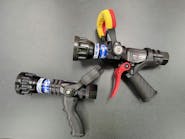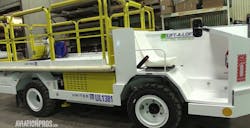From its composite fuselage and wings to the revolutionary way that some critical systems are electrically powered, The Boeing Co. has pushed the technology envelope with its 787 Dreamliner.
Among those advances is the first fuel-inerting system designed specifically for an all-new commercial jetliner.
The inerting system that will be used on the 787 works pretty much the same way as one that is being tested on two 747-400s and two 737-700s that are in service with airlines and cargo operators. Boeing won't identify those operators, but does say the four planes have about 10,000 hours of flight time with the inerting system in operation.
Starting next year, Boeing will install the system on all its factory-built 737s, 747s and 777s.
It works by taking some of the air generated by the engines and diverting it through a filter, which separates out nitrogen. The nitrogen is then pumped into the center wing tank as the fuel is used, rendering any fuel vapors inert, because the level of oxygen is too low to support a fire or explosion.
That system had to be modified for the 787, which will be the first commercial jetliner that does not use bleed air from the engines. On today's jets, bleed air is carried by a network of ducts through the plane, and some is used to pneumatically power certain systems. Air-driven pumps, for example, are used to raise the landing gear.
Eliminating bleed air from the engines and powering systems electrically on the 787 will make the Dreamliner more efficient, according to Boeing. But that meant engineers had to find a different way of getting a supply of air to produce nitrogen for the 787 fuel-inerting system.
Air will be drawn from inside the 787 under the cargo floor using a long tube with tiny holes in it that will run the length of the cargo bay. That air then goes into a compressor and an air-separation module that produces the nitrogen. The nitrogen is distributed through ducts to the 787 fuel tanks in the wings and the center wing fuel tank in the fuselage.
And that's another important difference in the 787 fuel-inerting system. All the wing tanks will receive the nitrogen gas, not just the center wing tank. The system that is under evaluation on the four Boeing jets in service, as well as the one that will be on Boeing production jets starting next year, is only on the center wing tank - the tank that exploded on TWA Flight 800.
The Federal Aviation Administration's final rule, which comes out later this year, is expected to require the industry to reduce the flammability of only center wing tanks.
Mike Sinnett, head of 787 systems, said Boeing decided it would be best to have a fuel-inerting system on all of the tanks on the 787.
"In the beginning, we did not have the analysis that we needed to demonstrate that we had to inert the wing tanks," he said. "We thought it would be a good thing to do, and the analysis now is bearing out that decision."
The 787 will be the first large commercial jetliner with a composite wing and fuselage. The thermal characteristics of a composite wing are different from a traditional airplane wing made of aluminum. Aluminum conducts heat much better than composites. What that means on the 787, Sinnett explained, is that it will take longer for the composite wing to heat up. But it also will take longer for the wing to cool down. So any fuel vapors in the 787 wing tanks would be potentially flammable for a slightly longer time than if the wing were made of aluminum.
If the 787 wings were aluminum, rather than composite, Boeing probably would have elected to have a fuel-inerting system for only the center fuel tank, Sinnett said.
The 787 inerting system will add about 200 pounds to each plane, or the equivalent of one passenger. At full power, it will draw about 40 kilowatts. Sinnett said the system operates automatically as a function of the flight profile and the electrical demands on the plane.
The system is also not "dispatch critical," Sinnett said. That means an airline could keep the jet in service for a period of time even if the inerting system malfunctioned.
One reason that airlines oppose fuel-inerting systems is a concern that they will add a layer of complexity that drives up maintenance costs and could keep a jet at the gate if the system were not working properly. Boeing is working with the FAA to allow a 787 to remain in service for up to 10 days if the fuel-inerting system should fail.
P-I aerospace reporter James Wallace can be reached at 206-448-8040 or .
787 FUEL SAFETY EFFORTS Boeing has developed a fuel-interting system for the 787 that reduces the level of oxygen in its fuel tanks to reduce the chance of an explosion
1) Air is drawn from a long tube with tiny holes in it that runs the length of the cargo bay.
2) The air goes through a compresser and is then filtered through a device that separates out the oxygen.
3) As fuel is used, nitrogen is pumped into the fuel tanks in the wings and the center fuel tank. The level of oxygen in the tanks would be too low to support a fire or explosion should there be an electrical spark, rendering any fuel vapors intert.
Source: The Boeing Co.





